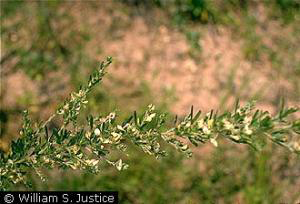Lespedeza cuneata was brought to the U.S. in the late 1800s and has been used for erosion control and mine reclamation, and as forage for domestic animals and wildlife. It is also used medicinally.
Photo Credit: © William S. Justice, USDA-NRCS PLANTS Database. Courtesy of Smithsonian Institution, Dept. of Systematic Biology, Botany.
Lespedeza cuneata
Common Name: sericia lespedeza
Other Common Names: Chinese lespedeza
Plant Functional Group: Forb
Class > Order > Family: Magnoliopsida > Fabales > Fabaceae
What does the species look like?
Sericea lespedeza is a single- to multi-stemmed, perennial, herbaceous plant to subshrub often woody at its base, growing 1.6 to 6 feet tall. This plant has two types of flowers that are self-pollinated: showier flowers that open, and inconspicuous flowers that don't open. The small, showier, whitish to light yellow, sometimes tinged with pink to purple flowers have both male and female parts and are arranged along the branches with the leaves.
Sericea lespedeza grows in sandy, loamy, or clay soils, on sites that are relatively open, and with little tree or shrub competition. Common sites are moderately moist to dry fields and pastures, waste ground, disturbed sites, travel corridors, grasslands, and prairies, as well as low open woodlands, thickets, stream valleys, lake and pond edges, ravines, slopes, and ridges. It is a drought-resistant plant.
Where is the species found?
States & Provinces
AL, AR, CT, DC, DE, FL, GA, HI, IA, IL, IN, KS, KY, LA, MA, MD, MI, MO, MS, NC, NE, NJ, NY, OH, OK, ON, PA, SC, TN, TX, VA, WI, WV
Special Considerations for Observing
If drought seems to be the cause of leaf senescence for a plant, please make a comment about it for that observation.
Which phenophases should I observe?
Do you see...?
Leaves
Initial growth More...
Leaves More...
Flowers
Flowers or flower buds More...
How many flowers and flower buds are present? For species in which individual flowers are clustered in flower heads, spikes or catkins (inflorescences), simply estimate the number of flower heads, spikes or catkins and not the number of individual flowers.
Less than 3 3 to 10 11 to 100 101 to 1,000 More than 1,000
Open flowers More...
What percentage of all fresh flowers (buds plus unopened plus open) on the plant are open? For species in which individual flowers are clustered in flower heads, spikes or catkins (inflorescences), estimate the percentage of all individual flowers that are open.
Less than 5% 5-24% 25-49% 50-74% 75-94% 95% or more
Fruits
Fruits Lespedeza cuneata , the fruit is a pod that changes from green to brown or dark brown.More...
How many fruits are present?
Less than 3 3 to 10 11 to 100 101 to 1,000 More than 1,000
Ripe fruits Lespedeza cuneata , a fruit is considered ripe when it has turned brown or dark-brown.More...
What percentage of all fruits (unripe plus ripe) on the plant are ripe?
Less than 5% 5-24% 25-49% 50-74% 75-94% 95% or more
Recent fruit or seed drop More...
How many mature fruits have dropped seeds or have completely dropped or been removed from the plant since your last visit?
Less than 3 3 to 10 11 to 100 101 to 1,000 More than 1,000
What do these phenophases look like?
There is currently no photoguide available for this species. If you'd like help us create one, use the guidance document and species template provided here . Then send it via email to education@usanpn.org when it is complete.
